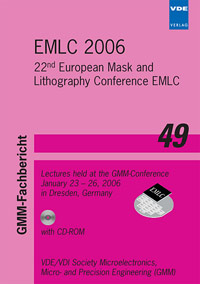How Refractive Microoptics Enable Lossless Hyper-NA Illumination Systems for Immersion Lithography
Conference: EMLC 2006 - 22nd European Mask and Lithography Conference
01/23/2006 - 01/26/2006 at Dresden, Germany
Proceedings: EMLC 2006
Pages: 8Language: englishTyp: PDF
Personal VDE Members are entitled to a 10% discount on this title
Authors:
Ganser, H.; Darscht, M.; Miklyaev, Y.; Hauschild, D.; Aschke, L. (LIMO Lissotschenko Mikrooptik GmbH, Germany)
Abstract:
Uniform illumination of the mask plays an important role in current exposure tools and will be even more challenging for hyper-NA systems. Arrays of refractive microoptics are the ideal solution for high transmission homogenising elements since these arrays can provide very steep intensity profiles (top hat and other profiles), and do not suffer from zero order losses like diffractive elements. This paper discusses monolithic elements based on crossed cylindrical lenses with a fill factor close to 100%. The Simulations and measurements here presented prove that microoptic arrays can be produced which provide a uniformity of the homogenized laser light in the 1% P-V range at numerical apertures above 0.3. Refractive microoptic arrays do not change the polarization state of the transmitted light which is an important prerequisite in immersion exposure tools. LIMO homogenizer sets are manufactured from fused silica and Calcium fluoride and thus suitable for all DUV wavelengths at highest laser fluxes. LIMO produces free form surfaces on monolithic arrays larger than 200 mm with high precision and reproducibility. Surface test methods and the final UV-tests are presented, guaranteeing the performance for the applications. Data gained with these tests are shown with regard to meeting the design parameters, reproducibility over one wafer and reproducibility in large lots. New concepts of “ready to use” pre-aligned homogenizer modules are shown and finally this paper illustrates results of new refractive elements which provide additional functionality like e.g. hexagonal fields or poles. Applications are for example pre-homogenization and pupil filling in illumination systems.


